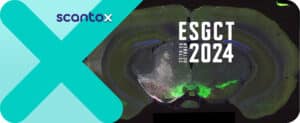As research on aging and longevity has become an increasingly important field in the quest to extend human health and lifespan, Scantox Neuro increases its service portfolio enabling in vitro and in vivo aging studies and subsequent biochemical and histological tissue analysis.
Aging refers to the progressive physiological changes in an organism that leads to a decline in biological function and increased vulnerability to stress and disease over time. It is a broad process that occurs throughout the adult life of living organisms. Cellular aging is often referred to as senescence.
Although aging is the primary risk factor for most neurodegenerative diseases, it is often connected to deterioration of cognitive and motor capabilities on its own. To model these deficits in vivo, next to aged wild type mice, SAMP8 mice represent a great opportunity for the field. These senescence-accelerated mice show aging-related deterioration as early as 4 months old by learning and motor deficits in the contextual fear conditioning test and wire hanging test, respectively (Figure 1).

Figure 1: Cognitive and motor deterioration in SAMP8 mice. SAMP8 mice were evaluated for learning deficits in the contextual fear conditioning test (A) and for motor deficits in the wire hanging test (B) at the age of 4 months. A: Mean freezing duration for 5 minutes after receiving the foot shock. B: Wire hanging time in seconds. 300 seconds cut-off time. Results were compared to SAMR1 mice of the same age as normally aging control. Mean + SEM, n = 12 per group, unpaired t-test, *p<0.05; ***p<0.001.
Histologically, several aging-related pathologies can be evaluated such as:
- Lipofuscin grains as marker of aging
- Microbleedings in the brain by Prussian Blue staining (Figure 2A)
- Spine density by Golgi-Cox silver impregnation (Figure 2B)
- Neurogenesis by doublecortin and BrdU staining (Figure 2C)
- …and many more are already available or can be established

Figure 2: Representative image of microbleeding, spines and neurogenesis. A: Blood vessel leakage in the grey and white matter of the cortex and corpus callosum, respectively, analyzed by Prussian Blue staining. B: Spine staining in the dentate gyrus and the hippocampal CA1 region. Spine density can be measured using a rater-independent approach. C: Neurogenesis in the hippocampal dentate gyrus by labelling doublecortin-positive neurons and staining of BrdU-positive nuclei.
Available aging-related biochemical readouts for SAMP8 mice include but are not limited to:
- TOMM20 as mitochondrial marker (Figure 3, A)
- p62 as marker of autophagy (Figure 3, B)
- p53 as marker of senescence
In addition to these readouts, aging models can be evaluated for:
- β-galactosidase activity as marker of autophagy and senescence
- Telomere length and telomerase activity as marker of senescence

Figure 3: Representative lane view of automated western blotting WES for TOMM20 and p62 in striatal tissue of mice. Different expression level of TOMM20 and p62 in striatal tissue of two different mouse groups (X vs. Y). For each group, tissue of 3 mice was analyzed. STD, standard.
Next to cerebral organoids as in vitro model of aging as presented in our January 2025 Science News, Scantox Neuro has also vast experiences in modelling aging and senescence in vivo. Tissues can be evaluated for aging and senescence-related biomarkers by various histological and biochemical methods.
Contact us today to get your aging and senescence study started!









